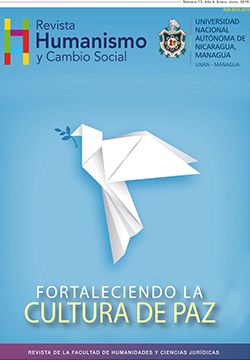Dialogue with young people: voices, experiences and narratives about suicide
DOI:
https://doi.org/10.5377/hcs.v0i13.8837Keywords:
Suicide, social stigmas, collective imaginary, narratives and voicesAbstract
In 2018, 800,000 people die and were counted worldwide by OMS. In Latin America, the average number of people who commit suicide is 9.8 per 100,000 inhabitants. The age group in which this event predominates is in a range of 14 to 35 years. In Nicaragua, suicide figures have boomed sharply, with 2017 being the most alarming year with more than 300 registered cases. The characteristics of suicidal behavior have been identified, being predominantly in urban areas, ages between 12 - 35 years between cities in the Pacific and North Central area and subsequently to the South Caribbean. The reasons identified with young people whom I dialogue with, arise different variables that combine, between specific family conflicts, aggressive / psychological bullying, belief systems that exclude, discriminate and condemn; patriarchal cultural systems, pedagogical procedures that overlooked specific situations and without identification of a pattern of abnormal behavior, mental illnesses whose illnesses are unknown, collective imaginary not compatible with their identity, and over all self-esteem problems. The objective of the article is to bring the reader closer to the phenomenon of suicide from the voices and narratives of its protagonists, as well as to describe the epidemiological behavior in the Latin American and national region.
Downloads
References
Del campo, A., González , C., & Bustamante, J. (2013). El suicidio en adolecentes. Revista Médica del Hospital General de México, 169-233.
Duarte Castellón, Z. (2014). Instituto de Medicina Legal. Retrieved from Muertes por suicidio en Nicaragua la más baja de la región: https://www.poderjudicial.gob.ni/pjupload/iml/pdf/suicidios.pdf
Gómez, V. (2017). Comportamiento epidemiológico del intento suicida en Nicaragua. Retrieved from Repositorio UNAN-Managua : http://repositorio.unan.edu.ni/9730/
Kolb, B., & Wishaw, I. (2006). Neuropsicología humana. Madrid: Editorial Médica Panamericana.
OMS. (2014). Prevención del suicidio: un imperativo global. Retrieved from Organización Mundial de la Salud : https://apps.who.int/iris/bitstream/handle/10665/
/9789275318508_spa.pdf;jsessionid=
B3A4F5FFC198915C9DF4F1F35A8F502C?sequence=1
OMS. (2018, Agosto 24). Organización Mundial de la Salud. Retrieved from https://www.who.int/es/news-room/fact-sheets/detail/suicide
OMS, OPS . (2016). WHO. Retrieved from El Suicidio según Vigilancia Epidemiológica: https://www.paho.org/nic/index.php?option=com_docman&view=download&category_slug=datos-y-estadisticas&alias=713-boletin-informativo-el-suicidio-segun-vigilancia-epidemiologica&Itemid=235
OPS. (2014). Organización Panamericana de la Salud. Retrieved from Factores y riesgo de suicidio en America Latina: http://iris.paho.org/xmlui/bitstream/handle/
/31167/9789275319192-spa.pdf?sequence=1&isAllowed=y




